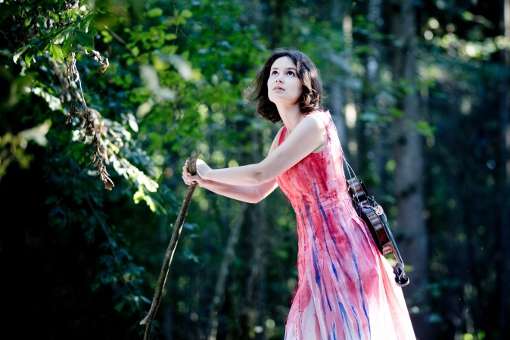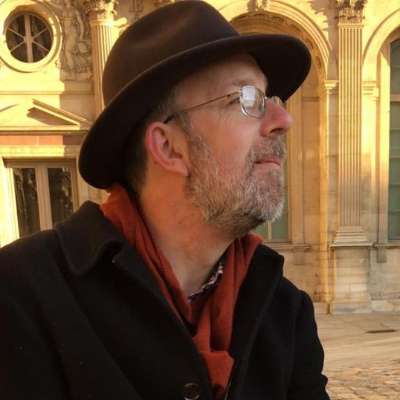“You have to be mad to make music!” Patricia Kopatchinskaja once told my colleague, Laurence Vittes. It’s a madness she’s seemed to embrace wholeheartedly. In an interview focusing on her love for contemporary music, I started by asking the Moldovan-born violinist what making music means to her in practice.

PK: It means exploring pieces, ways of playing them, to combine them, to get at their meaning; collaborating with inspiring composers, colleagues and friends; trying to help new music, creating settings for performances. The possibilities are endless. But the central point is to make myself as empty and receivable as possible, so that every piece at any point can find the best place in my brain, my heart and my hands. It’s like a mother who needs a belly for a new baby.
MP: Your concert programming and repertoire choices are always fiercely original, with contemporary music at the centre of what you play. Can you explain your ethos in regards to programming, specifically regarding contemporary music?
As with every higher animal, humans also possess exploratory, novelty-seeking behaviours. Of course you read today’s (and not yesterday’s) journals, young people hear the latest pop songs, ladies dress in the latest fashion, scientists explore the frontiers of knowledge about space and elementary particles and so on. In every instance, the driver is the hunger and the pleasure you get from discovering the unknown.
Now, of course, hearing Beethoven’s Coriolan Overture or the Pastoral Symphony for the first time can be an overwhelming experience. You can also hear them a second time and perhaps a third time and you can study details. But then the interest begins to fade and outside ritualistic behaviour I cannot find a reason to hear them again and again, only exceptionally, if played by particularly inspired people in a particularly inspired way or in a particularly inspiring setting.
Is “typical” concert programming – overture, concerto, symphony – something frustrates you?
As a soloist you can just play your concerto so you are not exposed to boring programmes. But I admit that I would have difficulty sitting through a concert with, let’s say, a typical overture, then the Dvořák Violin Concerto and after the intermission Mendelssohn’s “Reformation” Symphony. I would not see any meaning in this for today and, in any case, such concerts do not really need my participation. But there are also annoying limitations of the concert format itself – tailcoats, bowing, clapping, pauses. I always envied theatre for its freedom to innovate, to combine the old with the new and to use all the faculties of its performers, be it speaking, singing, gestures, acrobatics, staging, visual effects and whatever.
For some years we tried to move in such a direction with concerts staged around a meaningful theme: “Death and the Maiden” with the Saint Paul Chamber Orchestra explored the wherefrom and meaning of Schubert’s String Quartet. “Bye-Bye Beethoven” with the Mahler Chamber Orchestra articulated the uneasy feeling one gets by again and again playing and hearing the same old repertoire – music in the rearview mirror. We therefore started the concert with the musicians entering walking backwards and then playing the last movement of Haydn’s “Farewell” Symphony backwards. We ended with Beethoven’s Violin Concerto while the wall behind the orchestra began to move imperceptibly towards the audience so that the orchestra was eventually forced to leave the stage in general chaos.
With the Lucerne Festival Alumni, “Dies irae” was about our biosphere and civilisation being doomed by global warming. “War and Chips” with Camerata Bern was about our lack of involvement in what we are feeling and doing, be it in music, in the world and in life. All these were the collaborative efforts of many people, integrating stage, space, music-making, acting, dancing, light, video, electronics and sometimes discussions. There were no pauses or clapping in between. Although there were huge risks and many mishaps, we had the support of the organisers and the teams. And the involvement and satisfaction of participants and the public exceeded what you experience in many so-called “normal” concerts. There are rewards in taking risks and some of these productions now go into other capitals or even overseas.
Does the recital platform offer more artistic freedom?
Compared to the above not necessarily. Anyway you can only win the freedoms you dare to take – the limits are in the imagination. In recitals it depends on the partner. With Polina Leschenko, we can try to push the boundaries of imagination in well-known pieces. With Anthony Romaniuk, we can contrast historically informed performance with avant-garde and he is a real improvisator which opens up unheard of possibilities.
When you work on repertoire composed for you to première, how involved do you like to be with the composers? Is it a fully collaborative process?
This is an interesting question. I studied composition myself and I’m still occasionally compelled to compose. Therefore I know how it is to be inside the skin of a composer. When working with composers, of course one has to agree about the size and kind of ensemble, but beyond this I try to abstain from telling them anything or pushing them in any particular direction. I try not to disturb their freedom or inspiration. However I like it if composers explain their ideas and if they are present and comment during rehearsals. I feel privileged if I can ask them questions and fine-tune the performance to their expectations.
Which contemporary works or composers have made the biggest impact on you?
I tend to become an advocate of composers and works which are important to me. This is the case for Schoenberg, Berg, Webern, Ustvolskaya and Ligeti. Among living composers it would be Kurtág, Michael Hersch, Heinz Holliger, Francisco Coll, Mauricio Sotelo, Martón Illés and many others.
György Ligeti’s music often features in your schedules, especially the Violin Concerto coming in London and Snape. Can you describe the qualities you admire in his music? And what are the particular challenges and/or joys in interpreting it?
Ligeti’s concerto is written for 24 soloists, a terribly difficult puzzle for everybody, created with knowledge, instruments and materials from thousands of years. If successful, it becomes a strange luminous spaceship, rising into the air. Ligeti is the flight engineer, while Bartók and Pérotin are the passengers. It’s really exhilarating if you can make it fly! And I love the humour of Ligeti, with the possibility to create my own cadenza.
You often play music by another Hungarian, György Kurtág – I recall the Duos for Violin and Cimbalom from your compelling Rapsodia programme which draws on folk music roots. Was this love inherited from your parents? What are your earliest memories of music and performing?
After having studied violin and composition, I realised relatively late what a treasure of material and understanding the folk music of my parents is. Folk music is everywhere: in Biber, Beethoven, Schubert, Brahms, Mahler, Berg, and of course the Hungarians, Enescu, Ravel, De Falla and Charles Ives.
My earliest memories of music were my grandma singing at the sewing machine, my sister and mother playing the violin, my father the cimbalom. When I was a very small toddler I had to scratch something for guests and it seems that along with my violin I brought my potty and used it during my performance!
Do you have more or less licence to make extreme artistic choices when playing contemporary music? But you also enjoy challenging people’s preconceptions when interpreting “classics”, yes?
In modern music I work with composers whenever possible: Kurtág, Eötvös, Holliger, Salonen, Michael Hersch, Tigran Mansurian and many others. Not once in my life did I hear from a living composer that I had made extreme choices. On the contrary, Salonen once said: “Sometimes only too much is enough”. And Eötvös told me that in his Violin Concerto he had not thought that one could play a particular passage like this, but yes, I should go on. He was obviously amused by any new idea. I don’t think exaggeration is something negative.
Concerning the classics: I often help myself to escape routine by staging the piece in my head, writing a story, designing costumes, stage-setting, figures, asking how can I make it understandable even for a small child so that he doesn’t lose his attention, so that an old person doesn’t fall asleep and so that a young person comes again. It needs a new voice, language, ear and eyes in order to wipe off the dust from our classical temples.
Take Mozart for example. For me Mozart is always operatic, with many contrasting characters, dialogues and colours. If you understand it like this, you have to go for contrasts and sometimes abrupt changes. This is not the rounded afternoon tea-room experience and of course it will be felt as “provocative” by some. But I simply want to convey the music’s meaning as I understand it.
But if you are playing for a public who are just sitting there because of the said ritualistic behaviour it’s sometimes difficult to resist the urge to tickle or provoke them. This can happen, I have to admit!


